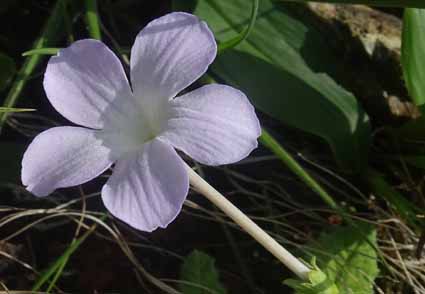Abstract
Primula sherriffiae W.W.Sm. has been collected after a gap of 74 years from Indo-Myanmar border, near Poi village, Manipur. It was last collected from India for the same state of Manipur in 1948. The species is very unique in having longest corolla tube (c. 10 cm long) so far, in all known Primula spp. Comments have been made on the typification of the name and possible threats and its conservation status are also discussed.
References
<p align="justify"><span style="color: #000000;"><span style="font-family: Times New Roman, serif;"><span style="font-size: small;"><span style="color: #05050a;"><span lang="en-GB">Basak, S.K., Maiti, G. & Hajra, P.K. (2014) </span></span><span style="color: #05050a;"><span lang="en-GB"><em>The Genus Primula L. in India</em></span></span><span style="color: #05050a;"><span lang="en-GB">. Bishen Singh Mahendra Pal Singh, Dehra Dun, pp. 1–668.</span></span></span></span></span></p>
<p align="justify"><span style="color: #000000;"><span style="font-family: Times New Roman, serif;"><span style="font-size: small;"><span style="color: #05050a;"><span lang="en-GB">Grierson, A.J.C. & Long, D.G. (2001) </span></span><span style="color: #05050a;"><span lang="en-GB"><em>Primula</em></span></span><span style="color: #05050a;"><span lang="en-GB"> L.</span></span><span style="color: #05050a;"><span lang="en-GB"><em> In: </em></span></span><span style="color: #05050a;"><span lang="en-GB">Grierson, A.J.C. & Long, D.G., </span></span><span style="color: #05050a;"><span lang="en-GB"><em>Flora of Bhutan</em></span></span> <span style="color: #05050a;"><span lang="en-GB"><em>Volume</em></span></span><span style="color: #05050a;"><span lang="en-GB"> 2. Royal Botanic Gardens, Edinburgh, pp. 515–554.</span></span></span></span></span></p>
<p align="justify"><span style="color: #000000;"><span style="font-family: Times New Roman, serif;"><span style="font-size: small;"><span style="color: #05050a;"><span lang="en-GB">IUCN (2012) </span></span><span style="color: #05050a;"><span lang="en-GB"><em>IUCN Red List Categories and Criteria: Version 3.1.</em></span></span><span style="color: #05050a;"><span lang="en-GB"> Second edition. Gland, Switzerland and Cambridge, UK: IUCN. iv + 32 pp. </span></span></span></span></span></p>
<p align="justify"><span style="color: #000000;"><span style="font-family: Times New Roman, serif;"><span style="font-size: small;"><span style="color: #05050a;"><span lang="en-GB">IUCN STANDARDS AND PETITIONS COMMITTEE (2019) </span></span><span style="color: #05050a;"><span lang="en-GB"><em>Guidelines for Using the IUCN Red List Categories and Criteria. Version 14</em></span></span><span style="color: #05050a;"><span lang="en-GB">. Prepared by the Standards and Petitions Committee. [http://www.iucnredlist.org/ documents/RedListGuidelines.pdf]</span></span></span></span></span></p>
<p align="justify"><span style="color: #000000;"><span style="font-family: Times New Roman, serif;"><span style="font-size: small;"><span style="color: #05050a;"><span lang="en-GB">Linnaeus, C. (1753) Species Plantarum</span></span><span style="color: #05050a;"><span lang="en-GB"><em>: Eexhibentes plantas rite cognitas, ad genera relatas, cum differentiis specificis, nominibus trivialibus, synonymis selectis, locis natalibus, secundum systema sexuale digestas</em></span></span><span style="color: #05050a;"><span lang="en-GB">, London, pp. 142–144. https://doi.org/10.5962/bhl.title.59734</span></span></span></span></span></p>
<p align="justify"><span style="color: #000000;"><span style="font-family: Times New Roman, serif;"><span style="font-size: small;"><span style="color: #05050a;"><span lang="en-GB">Smith, W.W. (1936) New and Interesting Plants. </span></span><span style="color: #05050a;"><span lang="en-GB"><em>New Flora and Silva</em></span></span><span style="color: #05050a;"><span lang="en-GB"> 8: 131–132.</span></span></span></span></span></p>
<p align="justify"><span style="color: #000000;"><span style="font-family: Times New Roman, serif;"><span style="font-size: small;"><span style="color: #05050a;"><span lang="en-GB">Tiwari, U.K. & Dash, S.S. (2020) </span></span><span style="color: #05050a;"><span lang="en-GB"><em>Primulaceae</em></span></span><span style="color: #05050a;"><span lang="en-GB">.</span></span><span style="color: #05050a;"><span lang="en-GB"><em> In: </em></span></span><span style="color: #05050a;"><span lang="en-GB">Dash, S.S. & Mao</span></span>,<span style="color: #05050a;"><span lang="en-GB"> A.A., </span></span><span style="color: #05050a;"><span lang="en-GB"><em>Flowering Plants of India: An Annotated Checklist (Dicotyledons - Vol. II)</em></span></span><span style="color: #05050a;"><span lang="en-GB">. Botanical Survey of India, Kolkata, pp. 31–48.</span></span></span></span></span></p>
<p align="justify"><span style="color: #000000;"><span style="font-family: Times New Roman, serif;"><span style="font-size: small;"><span style="color: #05050a;"><span lang="en-GB">Turland, N.J., Wiersema, J.H., Barrie, F.R., Greuter, W., Hawksworth, D.L., Herendeen, P.S., Knapp, S., Kusber, W.-H., Li, D.-Z., Marhold, K., May, T.W., McNeill, J., Monro, A.M., Prado, J., Price, M.J. & Smith, G.F. (eds.) (2018) </span></span><span style="color: #05050a;"><span lang="en-GB"><em>International Code of Nomenclature for algae, fungi, and plants (Shenzhen Code) adopted by the Nineteenth International Botanical Congress Shenzhen, China, July 2017</em></span></span><span style="color: #05050a;"><span lang="en-GB">. Regnum Vegetabile 159. Koeltz Botanical Books. </span></span></span></span></span></p>
<p align="justify"><span style="color: #000000;"><span style="font-family: Times New Roman, serif;"><span style="font-size: small;"><span style="color: #05050a;"><span lang="en-GB">Grierson, A.J.C. & Long, D.G. (2001) </span></span><span style="color: #05050a;"><span lang="en-GB"><em>Primula</em></span></span><span style="color: #05050a;"><span lang="en-GB"> L.</span></span><span style="color: #05050a;"><span lang="en-GB"><em> In: </em></span></span><span style="color: #05050a;"><span lang="en-GB">Grierson, A.J.C. & Long, D.G., </span></span><span style="color: #05050a;"><span lang="en-GB"><em>Flora of Bhutan</em></span></span> <span style="color: #05050a;"><span lang="en-GB"><em>Volume</em></span></span><span style="color: #05050a;"><span lang="en-GB"> 2. Royal Botanic Gardens, Edinburgh, pp. 515–554.</span></span></span></span></span></p>
<p align="justify"><span style="color: #000000;"><span style="font-family: Times New Roman, serif;"><span style="font-size: small;"><span style="color: #05050a;"><span lang="en-GB">IUCN (2012) </span></span><span style="color: #05050a;"><span lang="en-GB"><em>IUCN Red List Categories and Criteria: Version 3.1.</em></span></span><span style="color: #05050a;"><span lang="en-GB"> Second edition. Gland, Switzerland and Cambridge, UK: IUCN. iv + 32 pp. </span></span></span></span></span></p>
<p align="justify"><span style="color: #000000;"><span style="font-family: Times New Roman, serif;"><span style="font-size: small;"><span style="color: #05050a;"><span lang="en-GB">IUCN STANDARDS AND PETITIONS COMMITTEE (2019) </span></span><span style="color: #05050a;"><span lang="en-GB"><em>Guidelines for Using the IUCN Red List Categories and Criteria. Version 14</em></span></span><span style="color: #05050a;"><span lang="en-GB">. Prepared by the Standards and Petitions Committee. [http://www.iucnredlist.org/ documents/RedListGuidelines.pdf]</span></span></span></span></span></p>
<p align="justify"><span style="color: #000000;"><span style="font-family: Times New Roman, serif;"><span style="font-size: small;"><span style="color: #05050a;"><span lang="en-GB">Linnaeus, C. (1753) Species Plantarum</span></span><span style="color: #05050a;"><span lang="en-GB"><em>: Eexhibentes plantas rite cognitas, ad genera relatas, cum differentiis specificis, nominibus trivialibus, synonymis selectis, locis natalibus, secundum systema sexuale digestas</em></span></span><span style="color: #05050a;"><span lang="en-GB">, London, pp. 142–144. https://doi.org/10.5962/bhl.title.59734</span></span></span></span></span></p>
<p align="justify"><span style="color: #000000;"><span style="font-family: Times New Roman, serif;"><span style="font-size: small;"><span style="color: #05050a;"><span lang="en-GB">Smith, W.W. (1936) New and Interesting Plants. </span></span><span style="color: #05050a;"><span lang="en-GB"><em>New Flora and Silva</em></span></span><span style="color: #05050a;"><span lang="en-GB"> 8: 131–132.</span></span></span></span></span></p>
<p align="justify"><span style="color: #000000;"><span style="font-family: Times New Roman, serif;"><span style="font-size: small;"><span style="color: #05050a;"><span lang="en-GB">Tiwari, U.K. & Dash, S.S. (2020) </span></span><span style="color: #05050a;"><span lang="en-GB"><em>Primulaceae</em></span></span><span style="color: #05050a;"><span lang="en-GB">.</span></span><span style="color: #05050a;"><span lang="en-GB"><em> In: </em></span></span><span style="color: #05050a;"><span lang="en-GB">Dash, S.S. & Mao</span></span>,<span style="color: #05050a;"><span lang="en-GB"> A.A., </span></span><span style="color: #05050a;"><span lang="en-GB"><em>Flowering Plants of India: An Annotated Checklist (Dicotyledons - Vol. II)</em></span></span><span style="color: #05050a;"><span lang="en-GB">. Botanical Survey of India, Kolkata, pp. 31–48.</span></span></span></span></span></p>
<p align="justify"><span style="color: #000000;"><span style="font-family: Times New Roman, serif;"><span style="font-size: small;"><span style="color: #05050a;"><span lang="en-GB">Turland, N.J., Wiersema, J.H., Barrie, F.R., Greuter, W., Hawksworth, D.L., Herendeen, P.S., Knapp, S., Kusber, W.-H., Li, D.-Z., Marhold, K., May, T.W., McNeill, J., Monro, A.M., Prado, J., Price, M.J. & Smith, G.F. (eds.) (2018) </span></span><span style="color: #05050a;"><span lang="en-GB"><em>International Code of Nomenclature for algae, fungi, and plants (Shenzhen Code) adopted by the Nineteenth International Botanical Congress Shenzhen, China, July 2017</em></span></span><span style="color: #05050a;"><span lang="en-GB">. Regnum Vegetabile 159. Koeltz Botanical Books. </span></span></span></span></span></p>


